
Friday June 24, 2022
Data: The Lifeblood of PR
As the global data industry expands exponentially, digital customers have become the new oil. The current value of the data economy is expected to rise to more than $400 billion by 2025, according to PWC. This data boom has immense implications for several industries.
The practice of Public relations entails the management and dissemination of data between brands or organisations and the public. Public relations professionals utilize data and facts to influence public perception about a person, brand, or organization.
Modern public relations revolves around data, and in most cases, the success of a PR campaign depends not only on the available data but also on the quality of the data – its presentation and application.
Data Availability and Accessibility
Today, more data is being generated from a larger audience and at a quicker pace with increased digitization. With every human interaction, data is being generated and digital footprints created. Data pours in from sensors and devices that form the internet of things (IoT), from social networks, research data, government data, and from organizations with data systems.
As data exponentially increases, it needs to be accessible for it to be of any good. According to Forrester’s Research, 70% of companies that grew over 15% year on year believe external data from partners is strategic to their firm’s overall business strategy.
This means that PR firms must understand that they cannot produce all the data necessary to offer the right services to their clients. No one company can have a monopoly on data. There’s often tremendous benefit from data gotten from partners or external providers.
Data-driven content creation and distribution
The advent of the internet created a breeding ground for cheap and fast content production. However, More information is also now available to customers than ever before. They have the freedom to decide which media they will consume and which they will ignore. This consumer data is now gold and will help content marketers reach their audiences correctly. They can also tie content marketing strategies to their broader business goals.
PR agencies use data in gathering and delivering content. Insights such as the appropriate keywords to use, most engaging headings and tags, ideal post length, and of course, the right time to share content can all be provided by data. Proper analytics also informs agencies on the right platforms to share content on, the target audience that would provide the highest engagement and the style/pattern of distribution.
Defining your audience, and catering your content to them, is one of the hardest parts of good content marketing – but possibly the most essential. There are many different ways to garner information about your target audience’s interests, beliefs, and pain points
Tools such as Google Analytics can help you learn about what people are doing on your site, which pages they prefer, and which search terms are leading people to you. Google Search Console can help you conduct basic keyword research for free. A paid tool like SEMrush or Moz can offer more in-depth analysis.
Data and Campaign proofs
Without data, how can PR firms prove that their campaigns successfully influenced public opinion?
Undoubtedly, most clients want to ascertain the return on their investments in public relations. Thankfully, with data analytics, organisations can show how successful a campaign was as modern PR reporting has transcended from oral explanations to visuals. Metrics such as sales stats, social media reach and engagements, brand mentions and shares can now help PR agencies provide proof that a campaign was done and its degree of success.
Data and Future Projections
No one can accurately predict the future, but with historical data, it is possible to at least get a good idea of what it would possibly be like with data analytics. PR agencies can now use human behavioural insights provided by data analytics tools to improve future public relations campaigns more accurately.
Data-driven planning and strategy can significantly improve the generation of innovative campaign ideas, massively increase public acceptance of the next campaign, and drastically lower the total expenses incurred in achieving success while reducing the likelihood of any future PR disasters for the agency and her clients.
Data is becoming one of the most important corporate assets that can help drive revenue. It is indeed the lifeblood of public relations and the digital economy.
Curzon PR is a London-based PR firm working with clients globally. If you have any questions, please feel free to contact our Business Development Team bd@curzonpr.com







Follow us